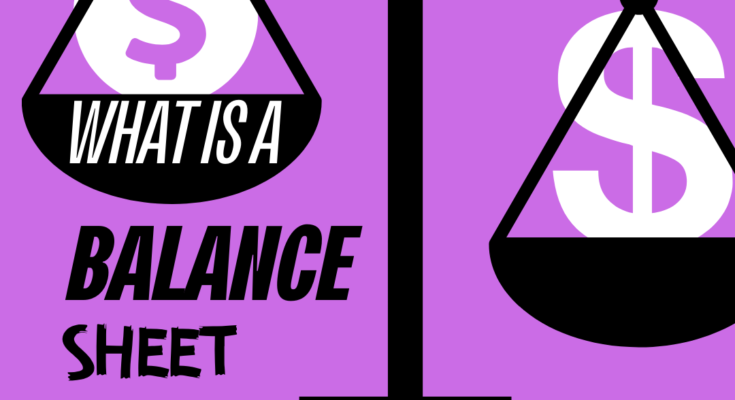Table of Contents
A balance sheet is an important financial reporting document that gives a company a summary of its assets, liabilities, and owners’ equity at a specific point in time. Also known as a statement of financial position, a balance sheet offers a snapshot of a company’s financial health, enabling business owners, investors, and other stakeholders to make informed decisions. In this article, we’ll delve into the components of a balance sheet, explore how it benefits both existing and startup businesses, and provide an example to illustrate its practical use.
Components of a Balance Sheet
A balance sheet is divided into three main sections: assets, liabilities, and equity. Understanding these components is essential for interpreting the financial position of a business.
Assets
Assets are resources owned by the business that have economic value. They are typically classified into two categories:
1. Current Assets: These are assets that are expected to be converted into cash or used up within one year. Examples include:
- Cash: Money available in the business’s bank accounts.
- Accounts Receivable: Money owed to the business by customers for goods or services provided on credit.
- Inventory: Goods available for sale.
2. Non-Current Assets: These are long-term assets that are not expected to be converted into cash within one year. Examples include:
- Property, Plant, and Equipment (PPE): Physical assets like buildings, machinery, and equipment.
- Intangible Assets: Non-physical assets such as patents, trademarks, and goodwill.
Liabilities
Liabilities are obligations or debts that the business owes to external parties. Similar to assets, liabilities are categorized into:
1. Current Liabilities: Obligations that are due within one year. Examples include:
- Accounts Payable: Money the business owes to suppliers for goods or services received.
- Short-Term Loans: Loans that need to be repaid within a year.
2. Non-Current Liabilities: Long-term obligations that are due after one year. Examples include:
- Long-Term Loans: Loans that are repayable over a period longer than one year.
- Bonds Payable: Debt securities issued by the company to raise capital.
Equity
Equity represents the owner’s interest in the business after all liabilities have been deducted from the assets. It includes:
- Owner’s Capital: Investments made by the business owners.
- Retained Earnings: Cumulative net income that has been retained in the business rather than distributed to the owners.

Purpose and Benefits of a Balance Sheet
A balance sheet serves multiple purposes and offers various benefits to both existing and startup businesses:
Assess Financial Health
The balance sheet provides insights into the financial health of a business by showing the relationship between its assets, liabilities, and equity. This helps in determining the company’s liquidity (ability to meet short-term obligations), solvency (ability to meet long-term obligations), and overall financial stability.
Evaluate Liquidity
By examining current assets and current liabilities, a balance sheet helps assess a company’s ability to meet its short-term obligations. This is crucial for maintaining smooth operations and avoiding financial distress.
Inform Decision-Making
Business owners and managers use the balance sheet to make informed decisions about investments, financing, and operational strategies. For example, if the balance sheet reveals a high level of accounts receivable, the business might implement stricter credit policies to improve cash flow.
Attract Investors and Lenders
Potential investors and lenders review the balance sheet to evaluate the risk and return associated with investing in or lending to the business. A strong balance sheet, indicating financial stability and a healthy balance of assets and liabilities, can attract investment and secure financing.
Track Financial Performance
Comparing balance sheets over different periods allows businesses to track their financial performance and growth over time. This helps in setting financial goals and measuring progress towards achieving them. For startups, a balance sheet can provide an early indication of financial viability and growth potential.

Example of a Balance Sheet
Below is a simplified example of a balance sheet for a small business:
| ABC Company | Balance Sheet | As of December 31, 2023 |
| Assets | ||
| Current Assets | ||
| Cash | $10,000 | |
| Accounts Receivable | $5,000 | |
| Inventory | $15,000 | |
| Total Current Assets | $30,000 | |
| Non-Current Assets | ||
| Property, Plant, and Equipment | $50,000 | |
| Intangible Assets | $10,000 | |
| Total Non-Current Assets | $60,000 | |
| Total Assets | $90,000 | |
| Liabilities and Equity | ||
| Current Liabilities | ||
| Accounts Payable | $8,000 | |
| Short-Term Loans | $12,000 | |
| Total Current Liabilities | $20,000 | |
| Non-Current Liabilities | ||
| Long-Term Loans | $30,000 | |
| Total Non-Current Liabilities | $30,000 | |
| Total Liabilities | $50,000 | |
| Equity | ||
| Owner’s Capital | $30,000 | |
| Retained Earnings | $10,000 | |
| Total Equity | $40,000 | |
| Total Liabilities and Equity | $90,000 |
How Existing and Startup Businesses Use Balance Sheets
Existing Businesses
For existing businesses, a balance sheet is a vital tool for ongoing financial management. It helps in:
- Monitoring Financial Health: Regularly reviewing the balance sheet helps identify trends and potential issues, such as declining cash balances or increasing debt levels.
- Strategic Planning: By understanding the company’s financial position, business owners can plan for future growth, including investments in new projects or expansion into new markets.
- Performance Measurement: Comparing balance sheets over time allows businesses to measure their financial progress and make necessary adjustments to achieve their goals.
Startup Businesses
For startups, a balance sheet is equally important, even though they might have fewer assets and liabilities initially. It helps in:
- Financial Viability: A balance sheet provides a clear picture of the startup’s financial standing, which is crucial for attracting investors and securing funding.
- Resource Allocation: Understanding the allocation of assets and liabilities helps startups manage their resources effectively, ensuring they have enough liquidity to support day-to-day operations.
- Growth Planning: Startups can use balance sheets to plan for future growth, identifying areas where additional capital might be needed and making informed decisions about scaling their operations.
Example Year 1 and Year 2 Balance Sheets
Year 1 Balance Sheet
| XYZ Company | Balance Sheet | As of December 31, 2023 |
| Assets | ||
| Current Assets | ||
| Cash | $15,000 | |
| Accounts Receivable | $10,000 | |
| Inventory | $20,000 | |
| Total Current Assets | $45,000 | |
| Non-Current Assets | ||
| Property, Plant, and Equipment (PPE) | $100,000 | |
| Intangible Assets | $5,000 | |
| Total Non-Current Assets | $105,000 | |
| Total Assets | $150,000 | |
| Liabilities and Equity | ||
| Current Liabilities | ||
| Accounts Payable | $12,000 | |
| Short-Term Loans | $8,000 | |
| Total Current Liabilities | $20,000 | |
| Non-Current Liabilities | ||
| Long-Term Loans | $50,000 | |
| Total Non-Current Liabilities | $50,000 | |
| Total Liabilities | $70,000 | |
| Equity | ||
| Owner’s Capital | $60,000 | |
| Retained Earnings | $20,000 | |
| Total Equity | $80,000 | |
| Total Liabilities and Equity | $150,000 |
Year 2 Balance Sheet
| XYZ Company | Balance Sheet | As of December 31, 2024 |
| Assets | ||
| Current Assets | ||
| Cash | $20,000 | |
| Accounts Receivable | $8,000 | |
| Inventory | $25,000 | |
| Total Current Assets | $53,000 | |
| Non-Current Assets | ||
| Property, Plant, and Equipment (PPE) | $120,000 | |
| Intangible Assets | $7,000 | |
| Total Non-Current Assets | $127,000 | |
| Total Assets | $180,000 | |
| Liabilities and Equity | ||
| Current Liabilities | ||
| Accounts Payable | $10,000 | |
| Short-Term Loans | $5,000 | |
| Total Current Liabilities | $15,000 | |
| Non-Current Liabilities | ||
| Long-Term Loans | $40,000 | |
| Total Non-Current Liabilities | $40,000 | |
| Total Liabilities | $55,000 | |
| Equity | ||
| Owner’s Capital | $60,000 | |
| Retained Earnings | $65,000 | |
| Total Equity | $125,000 | |
| Total Liabilities and Equity | $180,000 |
Analyzing the Changes Between Year 1 and Year 2
Changes in Assets
- Cash: Increased from $15,000 to $20,000
- This increase indicates improved liquidity, suggesting the company has more readily available funds for operations or unexpected expenses.
- Accounts Receivable: Decreased from $10,000 to $8,000
- A reduction in accounts receivable might indicate improved collections processes or a decrease in credit sales. This can be positive as it suggests better cash flow management.
- Inventory: Increased from $20,000 to $25,000
- An increase in inventory could indicate preparation for higher sales, but it could also suggest potential overstocking or slower sales. This requires further analysis to understand the underlying reason.
- Property, Plant, and Equipment (PPE): Increased from $100,000 to $120,000
- The increase in PPE suggests the company has invested in additional long-term assets, potentially to expand operations or improve efficiency.
- Intangible Assets: Increased from $5,000 to $7,000
- The increase in intangible assets might indicate the acquisition of new patents, trademarks, or other intellectual property, which can enhance the company’s competitive position.
Changes in Liabilities
- Accounts Payable: Decreased from $12,000 to $10,000
- A decrease in accounts payable indicates that the company is paying off its suppliers more promptly, which can be a sign of good financial health.
- Short-Term Loans: Decreased from $8,000 to $5,000
- The reduction in short-term loans suggests that the company is successfully managing its short-term debt, potentially reducing interest expenses and improving net income.
- Long-Term Loans: Decreased from $50,000 to $40,000
- A reduction in long-term loans indicates that the company is paying down its long-term debt, which can strengthen the balance sheet by reducing leverage.
Changes in Equity
- Owner’s Capital: Remained constant at $60,000
- No change in owner’s capital suggests that there were no additional investments by the owners during the year.
- Retained Earnings: Increased from $20,000 to $65,000
- A significant increase in retained earnings indicates that the company generated a substantial profit during the year, which has been retained in the business rather than distributed as dividends. This boosts the company’s financial strength and provides funds for future growth.
Interpreting the Changes
The changes in the balance sheet from Year 1 to Year 2 indicate several positive developments for XYZ Company:
- Improved Liquidity: The increase in cash and decrease in short-term liabilities suggest better liquidity management. This means the company is in a stronger position to meet its short-term obligations and invest in opportunities as they arise.
- Effective Debt Management: The reduction in both short-term and long-term loans indicates prudent debt management, which reduces financial risk and interest expenses, enhancing the company’s profitability.
- Increased Investment: The growth in non-current assets, such as PPE and intangible assets, indicates that the company is investing in its future growth and competitive positioning. This can lead to increased operational capacity and market strength.
- Strong Profitability: The significant rise in retained earnings reflects robust profitability. This provides a buffer for the company and funds for reinvestment, supporting long-term sustainability and growth.
- Operational Efficiency: The decrease in accounts receivable and accounts payable suggests improved operational efficiency in managing both collections and supplier payments.
By studying the balance sheets for Year 1 and Year 2, XYZ Company can gain valuable insights into its financial performance and make informed strategic decisions. The improvements in liquidity, debt management, asset investment, and profitability indicate a positive trajectory for the business, positioning it well for future growth and stability. Regularly reviewing balance sheets helps businesses stay on top of their financial health, identify areas for improvement, and capitalize on opportunities for expansion.
Conclusion
In summary, a balance sheet is a critical financial document that offers a comprehensive view of a company’s financial position. It helps businesses of all sizes, from startups to established companies, monitor their financial health, make strategic decisions, and communicate their financial status to stakeholders. By regularly reviewing and understanding their balance sheets, businesses can ensure they remain financially stable and poised for growth.




